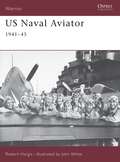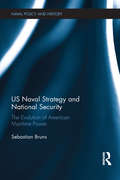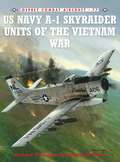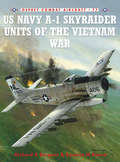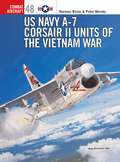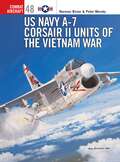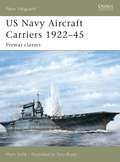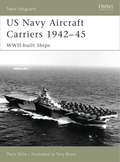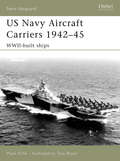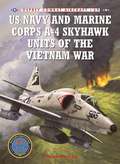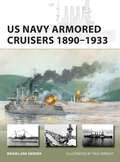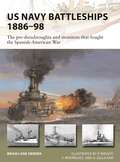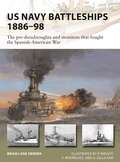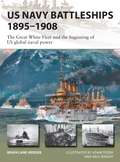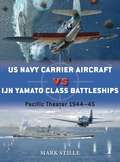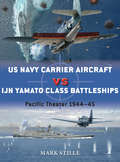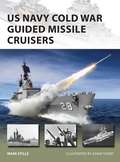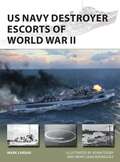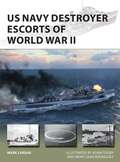- Table View
- List View
US Naval Aviator: 1941–45 (Warrior #52)
by Robert HargisThe US naval aviator of World War II played a pivotal part in the winning of the war. From the warm waters of the Pacific to the icy conditions of the Bering Sea (including the battle of Midway), the Naval aviator was on hand to fight the enemy in any and all conditions. Between 1940 and 1942 the training of the naval aviator lasted eleven months, divided into five separate and distinct phases. From phase one, known as the Elimination or "E" base for short, through to final assignment to a carrier based squadron, the training was demanding and unrelenting.This title examines the life and experiences of the US Naval Aviator in all three types of carrier squadron fighters (VF), dive-bombers (VB) and the torpedo squadrons (VT). From recruitment to battle, the detail of what it was like to fly and fight for the US Navy is brought vividly to life.
US Naval Strategy and National Security: The Evolution of American Maritime Power (Cass Series: Naval Policy and History)
by Sebastian BrunsThis book examines US naval strategy and the role of American seapower over three decades, from the late 20th century to the early 21st century. This study uses the concept of seapower as a framework to explain the military and political application of sea power and naval force for the United States of America. It addresses the context in which strategy, and in particular US naval strategy and naval power, evolves and how US naval strategy was developed and framed in the international and national security contexts. It explains what drove and what constrained US naval strategy and examines selected instances where American sea power was directed in support of US defense and security policy ends – and whether that could be tied to what a given strategy proposed. The work utilizes naval capstone documents in the framework of broader maritime conceptual and geopolitical thinking, and discusses whether these documents had lasting influences in the strategic mind-set, the force structure, and other areas of American sea power. Overall, this work provides a deeper understanding of the crafting of US naval strategy since the final decade of the Cold War, its contextual and structural framework setting, and its application. To that end, the work bridges the gap between the thinking of American naval officers and planners on the one hand and academic analyses of Navy strategy on the other hand. It also presents the trends in the use of naval force for foreign policy objectives and into strategy-making in the American policy context. This book will be of much interest to students of naval power, maritime strategy, US national security and international relations in general.
US Naval Strategy and National Security: The Evolution of American Maritime Power (Cass Series: Naval Policy and History)
by Sebastian BrunsThis book examines US naval strategy and the role of American seapower over three decades, from the late 20th century to the early 21st century. This study uses the concept of seapower as a framework to explain the military and political application of sea power and naval force for the United States of America. It addresses the context in which strategy, and in particular US naval strategy and naval power, evolves and how US naval strategy was developed and framed in the international and national security contexts. It explains what drove and what constrained US naval strategy and examines selected instances where American sea power was directed in support of US defense and security policy ends – and whether that could be tied to what a given strategy proposed. The work utilizes naval capstone documents in the framework of broader maritime conceptual and geopolitical thinking, and discusses whether these documents had lasting influences in the strategic mind-set, the force structure, and other areas of American sea power. Overall, this work provides a deeper understanding of the crafting of US naval strategy since the final decade of the Cold War, its contextual and structural framework setting, and its application. To that end, the work bridges the gap between the thinking of American naval officers and planners on the one hand and academic analyses of Navy strategy on the other hand. It also presents the trends in the use of naval force for foreign policy objectives and into strategy-making in the American policy context. This book will be of much interest to students of naval power, maritime strategy, US national security and international relations in general.
US Navy A-1 Skyraider Units of the Vietnam War (Combat Aircraft)
by Jim Laurier Rick Burgess Zip RausaNicknamed the 'flying dump truck', the A-1 was a key component in naval air wings from the end of World War II into the 1960s, allowing the aircraft to play its part in the escalating conflict in Vietnam. Both A-1 attack and EA-1F airborne early warning aircraft saw action in Southeast Asia from 1960 through 1969, when the last examples were finally retired from carrier decks. The A-1s in particular bombed targets in both North and South Vietnam, despite the aircraft being highly vulnerable to enemy flak and fighters. Co-written by a two-tour Vietnam War combat veteran in the A-1, this is the first book that focuses exclusively on the aircraft's service in Vietnam.
US Navy A-1 Skyraider Units of the Vietnam War (Combat Aircraft #77)
by Jim Laurier Rick Burgess Zip RausaNicknamed the 'flying dump truck', the A-1 was a key component in naval air wings from the end of World War II into the 1960s, allowing the aircraft to play its part in the escalating conflict in Vietnam. Both A-1 attack and EA-1F airborne early warning aircraft saw action in Southeast Asia from 1960 through 1969, when the last examples were finally retired from carrier decks. The A-1s in particular bombed targets in both North and South Vietnam, despite the aircraft being highly vulnerable to enemy flak and fighters. Co-written by a two-tour Vietnam War combat veteran in the A-1, this is the first book that focuses exclusively on the aircraft's service in Vietnam.
US Navy A-7 Corsair II Units of the Vietnam War (Combat Aircraft)
by Jim Laurier Peter Mersky Norman W BirzerArriving on station with the USS Ranger (CVA-61) in early December 1967, the first Corsair II squadron became operational immediatedly and sustained its first combat loss three weeks later. This book tells how the A-7 soon proved its worth supporting ground operations in South Vietnam. As it continued to serve in the ground support role, the navy swiftly introduced the A-7E which soon ran into difficulties with supply lines perhaps on account of what many perceived to have been a rushed introduction to service. Once these teething problems were resolved, the A-7E became the primary air-to-ground aircraft of the fleet.
US Navy A-7 Corsair II Units of the Vietnam War (Combat Aircraft)
by Peter Mersky Norman W BirzerArriving on station with the USS Ranger (CVA-61) in early December 1967, the first Corsair II squadron became operational immediatedly and sustained its first combat loss three weeks later. This book tells how the A-7 soon proved its worth supporting ground operations in South Vietnam. As it continued to serve in the ground support role, the navy swiftly introduced the A-7E which soon ran into difficulties with supply lines perhaps on account of what many perceived to have been a rushed introduction to service. Once these teething problems were resolved, the A-7E became the primary air-to-ground aircraft of the fleet.
US Navy Aircraft Carriers 1922–45: Prewar classes (New Vanguard)
by Tony Bryan Mark StilleThe USS Langley, the first American aircraft carrier, entered service in 1922. Despite being converted into an aircraft tender, it was the first step in a new direction for the US Navy and naval warfare. This book covers the design, development and operation of USN aircraft carriers built prior to World War II, including their aircraft and weaponry. It also explains their various successes and losses such as the first carrier vs carrier battle at Midway; the battle of the Coral Sea; the battle of the Philippine Sea; and the Operation Torch landings.
US Navy Aircraft Carriers 1922–45: Prewar classes (New Vanguard #114)
by Tony Bryan Mark StilleThe USS Langley, the first American aircraft carrier, entered service in 1922. Despite being converted into an aircraft tender, it was the first step in a new direction for the US Navy and naval warfare. This book covers the design, development and operation of USN aircraft carriers built prior to World War II, including their aircraft and weaponry. It also explains their various successes and losses such as the first carrier vs carrier battle at Midway; the battle of the Coral Sea; the battle of the Philippine Sea; and the Operation Torch landings.
US Navy Aircraft Carriers 1942–45: WWII-built ships (New Vanguard)
by Tony Bryan Mark StilleAircraft carriers were the US Navy's principal weapon against Japan during the Pacific War. Development of the Essex class began in 1939, becoming the largest class of carrier ever to be built. Early in the Pacific War it became renowned for its 'Sunday Punch' of 36 fighter planes, 36 dive bombers, and 18 torpedo planes. Alongside the lighter Independence class, these carriers formed the formidable Fast Carrier Force in the Pacific. Featuring artwork detailing the interior and exterior features of the ships, this book explores their design, development, and the action they saw in the Pacific, including the climactic battles of Philippine Sea, Leyte Gulf, and Okinawa.
US Navy Aircraft Carriers 1942–45: WWII-built ships (New Vanguard #130)
by Mark StilleAircraft carriers were the US Navy's principal weapon against Japan during the Pacific War. Development of the Essex class began in 1939, becoming the largest class of carrier ever to be built. Early in the Pacific War it became renowned for its 'Sunday Punch' of 36 fighter planes, 36 dive bombers, and 18 torpedo planes. Alongside the lighter Independence class, these carriers formed the formidable Fast Carrier Force in the Pacific. Featuring artwork detailing the interior and exterior features of the ships, this book explores their design, development, and the action they saw in the Pacific, including the climactic battles of Philippine Sea, Leyte Gulf, and Okinawa.
US Navy and Marine Corps A-4 Skyhawk Units of the Vietnam War 1963–1973 (Combat Aircraft)
by Jim Laurier Peter MerskyThe Skyhawk was involved in Vietnam from the very beginning, including the first offensive operations in 1963 into Laos, and the Pierce Arrow operations immediately following the Tonkin Gulf Incident of August 1964. Navy and Marine Corps A-4s quickly established a presence in south-east Asia participating in thousands of sorties against the entrenched communist forces in the South and the heavily defended targets in North Vietnam. A-4 pilots also struck targets along the infamous Ho Chi Minh Trail, working with ground-based and airborne forward air controllers to interdict the flood of supplies to communist forces in the south. This book will include many first-hand accounts from the pilots who flew one of the greatest attack aircraft ever built and will provide an insightful account of some of the most thrilling aerial combats that took place during Vietnam.
US Navy and Marine Corps A-4 Skyhawk Units of the Vietnam War 1963–1973 (Combat Aircraft #69)
by Jim Laurier Peter MerskyThe Skyhawk was involved in Vietnam from the very beginning, including the first offensive operations in 1963 into Laos, and the Pierce Arrow operations immediately following the Tonkin Gulf Incident of August 1964. Navy and Marine Corps A-4s quickly established a presence in south-east Asia participating in thousands of sorties against the entrenched communist forces in the South and the heavily defended targets in North Vietnam. A-4 pilots also struck targets along the infamous Ho Chi Minh Trail, working with ground-based and airborne forward air controllers to interdict the flood of supplies to communist forces in the south. This book will include many first-hand accounts from the pilots who flew one of the greatest attack aircraft ever built and will provide an insightful account of some of the most thrilling aerial combats that took place during Vietnam.
US Navy Armored Cruisers 1890–1933 (New Vanguard)
by Brian Lane HerderA new history of the large, fast, and long-ranged armored cruisers of the US Navy, and the roles that these warships played in the fleet as America developed into a great naval power.At the dawn of the “Steel Navy” era, the rapidly expanding US Navy's fleet of capital ships consisted not only of battleships but also armored cruisers, the forerunner of the battlecruiser. Armored cruisers sacrificed the battleship's superlative firepower and protection for superior speed and range but, as this study shows, their role was not always easy to define. Controversial because they were as large and expensive as battleships but not able to withstand a battleship in battle, contemporary strategists pointed out that, “naval wars are not won by running away from stronger ships.”Despite being produced at great expense, tactically they never really had a legitimate mission–traditional deployments were commerce raiding and protection, but despite this, author Brian Lane Herder illustrates how successful the use of armored cruisers was for the US Navy. After 1906, some replaced US battleships in the Pacific, functioning as oversized gunboats, most notably, the modified armored cruiser Pennsylvania which witnessed the first landing of an airplane on a ship. On November 5, 1915, North Carolina became the first cruiser to launch an aircraft from a catapult while underway. After the war, surviving US armored cruisers represented the US Navy on their Asiatic station until the final cruiser was scuttled in 1946.Using detailed, color artwork and photos, this fascinating book describes the development and deployment of these controversial but intriguing ships, providing examples of the key service they played in the US Navy in a variety of defensive and escorting roles.
US Navy Armored Cruisers 1890–1933 (New Vanguard)
by Brian Lane HerderA new history of the large, fast, and long-ranged armored cruisers of the US Navy, and the roles that these warships played in the fleet as America developed into a great naval power.At the dawn of the “Steel Navy” era, the rapidly expanding US Navy's fleet of capital ships consisted not only of battleships but also armored cruisers, the forerunner of the battlecruiser. Armored cruisers sacrificed the battleship's superlative firepower and protection for superior speed and range but, as this study shows, their role was not always easy to define. Controversial because they were as large and expensive as battleships but not able to withstand a battleship in battle, contemporary strategists pointed out that, “naval wars are not won by running away from stronger ships.”Despite being produced at great expense, tactically they never really had a legitimate mission–traditional deployments were commerce raiding and protection, but despite this, author Brian Lane Herder illustrates how successful the use of armored cruisers was for the US Navy. After 1906, some replaced US battleships in the Pacific, functioning as oversized gunboats, most notably, the modified armored cruiser Pennsylvania which witnessed the first landing of an airplane on a ship. On November 5, 1915, North Carolina became the first cruiser to launch an aircraft from a catapult while underway. After the war, surviving US armored cruisers represented the US Navy on their Asiatic station until the final cruiser was scuttled in 1946.Using detailed, color artwork and photos, this fascinating book describes the development and deployment of these controversial but intriguing ships, providing examples of the key service they played in the US Navy in a variety of defensive and escorting roles.
US Navy Battleships 1886–98: The pre-dreadnoughts and monitors that fought the Spanish-American War (New Vanguard)
by Brian Lane HerderAfter the American Civil War, the US Navy had been allowed to decay into complete insignificance, yet the commissioning of the modern Brazilian battleship Riachuelo and poor performance against the contemporary Spanish fleet, forced the US out of its isolationist posture towards battleships. The first true US battleships began with the experimental Maine and Texas, followed by the three-ship Indiana class, and the Iowa class, which incorporated lessons from the previous ships. These initial ships set the enduring US battleship standard of being heavily armed and armoured at the expense of speed. This fully illustrated study examines these first six US battleships, a story of political compromises, clean sheet designs, operational experience, and experimental improvements. These ships directly inspired the creation of an embryonic American military-industrial complex, enabled a permanent outward-looking shift in American foreign policy and laid the foundations of the modern US Navy.
US Navy Battleships 1886–98: The pre-dreadnoughts and monitors that fought the Spanish-American War (New Vanguard)
by Brian Lane HerderAfter the American Civil War, the US Navy had been allowed to decay into complete insignificance, yet the commissioning of the modern Brazilian battleship Riachuelo and poor performance against the contemporary Spanish fleet, forced the US out of its isolationist posture towards battleships. The first true US battleships began with the experimental Maine and Texas, followed by the three-ship Indiana class, and the Iowa class, which incorporated lessons from the previous ships. These initial ships set the enduring US battleship standard of being heavily armed and armoured at the expense of speed. This fully illustrated study examines these first six US battleships, a story of political compromises, clean sheet designs, operational experience, and experimental improvements. These ships directly inspired the creation of an embryonic American military-industrial complex, enabled a permanent outward-looking shift in American foreign policy and laid the foundations of the modern US Navy.
US Navy Battleships 1895–1908: The Great White Fleet and the beginning of US global naval power (New Vanguard)
by Brian Lane HerderThe last predreadnought battleships of the US Navy were critical to the technological development of US battleships, and they were the first tool of international hard power wielded by the United States, a nation which would eventually become the world's dominant political and military power of the 20th century. These battleships were the stars of the 1907–09 Great White Fleet circumnavigation, in which the emerging power and reach of the US Navy was displayed around the world. They also took part in the bombardment and landings at Veracruz, some served as convoy escorts in World War I, and the last two were transferred to the Hellenic Navy and were sunk during World War II. This book examines the design, history, and technical qualities of the final six classes of US predreadnought battleships, all of which were involved in the circumnavigation of the Great White Fleet. These classes progressively closed the quality gap with European navies – the Connecticuts were the finest predreadnought battleships ever built – and this book also compares and contrasts US predreadnought battleships to their foreign contemporaries. Packed with illustrations and specially commissioned artwork, this is an essential guide to the development of US Navy Battleships at the turn of the twentieth century.
US Navy Battleships 1895–1908: The Great White Fleet and the beginning of US global naval power (New Vanguard #286)
by Brian Lane HerderThe last predreadnought battleships of the US Navy were critical to the technological development of US battleships, and they were the first tool of international hard power wielded by the United States, a nation which would eventually become the world's dominant political and military power of the 20th century. These battleships were the stars of the 1907–09 Great White Fleet circumnavigation, in which the emerging power and reach of the US Navy was displayed around the world. They also took part in the bombardment and landings at Veracruz, some served as convoy escorts in World War I, and the last two were transferred to the Hellenic Navy and were sunk during World War II. This book examines the design, history, and technical qualities of the final six classes of US predreadnought battleships, all of which were involved in the circumnavigation of the Great White Fleet. These classes progressively closed the quality gap with European navies – the Connecticuts were the finest predreadnought battleships ever built – and this book also compares and contrasts US predreadnought battleships to their foreign contemporaries. Packed with illustrations and specially commissioned artwork, this is an essential guide to the development of US Navy Battleships at the turn of the twentieth century.
US Navy Carrier Aircraft vs IJN Yamato Class Battleships: Pacific Theater 1944–45 (Duel #69)
by Jim Laurier Mark StilleAs the Pacific War approached a crescendo, the clashes between swarming US Navy carrier aircraft, and the gigantic Imperial Japanese Navy (IJN) Yamato-class battleships became symbolic of the fortunes of the two nations. They also served as a metaphor for the profound changes in naval technology and doctrine that the war had brought about. The two opposing forces were the most powerful of their kind - the Japanese Yamato and Musashi were the biggest most heavily armored and armed battleships ever built, while US carrier aviation had evolved into a well-oiled, war-winning machine. With detailed analysis of the technical features of the opposing war machines and a gripping account of the fighting itself, this vividly illustrated work presents views from the cockpits of US Navy Divebombers, and down the sights of IJN anti-aircraft guns, during two of the most dramatic naval engagements ever fought.
US Navy Carrier Aircraft vs IJN Yamato Class Battleships: Pacific Theater 1944–45 (Duel #69)
by Jim Laurier Mark StilleAs the Pacific War approached a crescendo, the clashes between swarming US Navy carrier aircraft, and the gigantic Imperial Japanese Navy (IJN) Yamato-class battleships became symbolic of the fortunes of the two nations. They also served as a metaphor for the profound changes in naval technology and doctrine that the war had brought about. The two opposing forces were the most powerful of their kind - the Japanese Yamato and Musashi were the biggest most heavily armored and armed battleships ever built, while US carrier aviation had evolved into a well-oiled, war-winning machine. With detailed analysis of the technical features of the opposing war machines and a gripping account of the fighting itself, this vividly illustrated work presents views from the cockpits of US Navy Divebombers, and down the sights of IJN anti-aircraft guns, during two of the most dramatic naval engagements ever fought.
US Navy Cold War Guided Missile Cruisers (New Vanguard #278)
by Mark StilleFaced with an increasingly formidable anti-ship cruise missile threat from the Soviet Union in the early days of the Cold War, and with the recent memory of the kamikaze threat from World War II, the USN placed a great priority on developing air defence cruise missiles and getting them to sea to protect the fleet. The first of these missiles were sizable, necessitating large ships to carry them and their sensors, which resulted in the conversion of a mix of heavy and light cruisers. These ships, tasked with protecting carrier groups and acting as flagships, entered service from 1955 and served until 1980. The cruisers served in the front lines of the Cold War and many saw combat service, engaging in surface actions from Vietnam to the Persian Gulf. Complementing the conventionally-powered missile cruisers was a much smaller number of expensive nuclear-powered cruisers, including the Long Beach, the USN's largest-ever missile cruiser. Until replaced by the Ticonderoga and Burke classes of Aegis ships, the USN's 38 missile cruisers were the most capable and important surface combatants in the fleet and served all over the globe during the Cold War. Using specially commissioned artwork and meticulous research, this illustrated title explores the story of these cruisers in unparalleled detail, revealing the history behind their development and employment.
US Navy Cold War Guided Missile Cruisers (New Vanguard #278)
by Mark StilleFaced with an increasingly formidable anti-ship cruise missile threat from the Soviet Union in the early days of the Cold War, and with the recent memory of the kamikaze threat from World War II, the USN placed a great priority on developing air defence cruise missiles and getting them to sea to protect the fleet. The first of these missiles were sizable, necessitating large ships to carry them and their sensors, which resulted in the conversion of a mix of heavy and light cruisers. These ships, tasked with protecting carrier groups and acting as flagships, entered service from 1955 and served until 1980. The cruisers served in the front lines of the Cold War and many saw combat service, engaging in surface actions from Vietnam to the Persian Gulf. Complementing the conventionally-powered missile cruisers was a much smaller number of expensive nuclear-powered cruisers, including the Long Beach, the USN's largest-ever missile cruiser. Until replaced by the Ticonderoga and Burke classes of Aegis ships, the USN's 38 missile cruisers were the most capable and important surface combatants in the fleet and served all over the globe during the Cold War. Using specially commissioned artwork and meticulous research, this illustrated title explores the story of these cruisers in unparalleled detail, revealing the history behind their development and employment.
US Navy Destroyer Escorts of World War II (New Vanguard)
by Mark LardasThe Destroyer Escort was the smallest ocean-going escort built for the United States Navy – a downsized destroyer with less speed, fewer guns, and fewer torpedoes than its big brother, the fleet destroyer. Destroyer escorts first went into production because the Royal Navy needed an escort warship which was larger than a corvette, but which could be built faster than a destroyer. Lacking the shipyards to build these types of ships in Britain, they ordered them in the US. Once the US unexpectedly entered World War II, its navy suddenly also needed more escort warships, even warships less capable than destroyers, and the destroyer escort was reluctantly picked to fill the gap. Despite the Navy's initial reservations, these ships did yeoman service during World War II, fighting in both the Atlantic and Pacific, taking on both U-boat and Japanese submarines and serving as the early warning pickets against kamikazes later in the war. They also participated in such dramatic actions as the Battle of Samar (where a group of destroyers and destroyer escorts fought Japanese battleships and cruisers to protect the escort carriers they were shielding) and the capture of the U-505 (the only major naval vessel captured at sea by the US Navy). The destroyer escorts soldiered on after World War II in both the United States Navy and a large number of navies throughout the world, with several serving into the twenty-first century. This book tells the full story of these plucky ships, from their design and development to their service around the world, complete with stunning illustrations and contemporary photographs.
US Navy Destroyer Escorts of World War II (New Vanguard #289)
by Mark LardasThe Destroyer Escort was the smallest ocean-going escort built for the United States Navy – a downsized destroyer with less speed, fewer guns, and fewer torpedoes than its big brother, the fleet destroyer. Destroyer escorts first went into production because the Royal Navy needed an escort warship which was larger than a corvette, but which could be built faster than a destroyer. Lacking the shipyards to build these types of ships in Britain, they ordered them in the US. Once the US unexpectedly entered World War II, its navy suddenly also needed more escort warships, even warships less capable than destroyers, and the destroyer escort was reluctantly picked to fill the gap. Despite the Navy's initial reservations, these ships did yeoman service during World War II, fighting in both the Atlantic and Pacific, taking on both U-boat and Japanese submarines and serving as the early warning pickets against kamikazes later in the war. They also participated in such dramatic actions as the Battle of Samar (where a group of destroyers and destroyer escorts fought Japanese battleships and cruisers to protect the escort carriers they were shielding) and the capture of the U-505 (the only major naval vessel captured at sea by the US Navy). The destroyer escorts soldiered on after World War II in both the United States Navy and a large number of navies throughout the world, with several serving into the twenty-first century. This book tells the full story of these plucky ships, from their design and development to their service around the world, complete with stunning illustrations and contemporary photographs.
